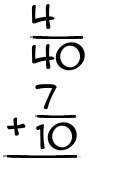What is 4/40 + 7/10?

|
Here's how you add
|
||||||||||||||||||||||||||||||||
Step 1Our denominators (bottom numbers) don't match, so we can't add yet. 40 goes into 10 evenly, so we only need to multiply one term to get a common denominator. Multiply 7 by 4, and get 28, then we multiply 10 by 4 and get 40. This gives us a new problem that looks like so:
|
||||||||||||||||||||||||||||||||
Step 2Since our denominators match, we can add the numerators. 4 + 28 = 32 So what's the answer so far?
|
||||||||||||||||||||||||||||||||
Step 3Can this fraction be reduced? First, we attempt to divide it by 2... Are both the numerator and the denominator evenly divisible by 2? Yes! So we reduce it:
Now, try the same number again. Are both the numerator and the denominator evenly divisible by 2? Yes! So we reduce it:
Now, try the same number again. Are both the numerator and the denominator evenly divisible by 2? Yes! So we reduce it:
Now, try the same number again. Nope. Try the next prime number, 3... Nope. Try the next prime number, 5... No good. 5 is larger than 4. So we're done reducing. Congratulations! Here's your final answer to 4/40 + 7/10
|